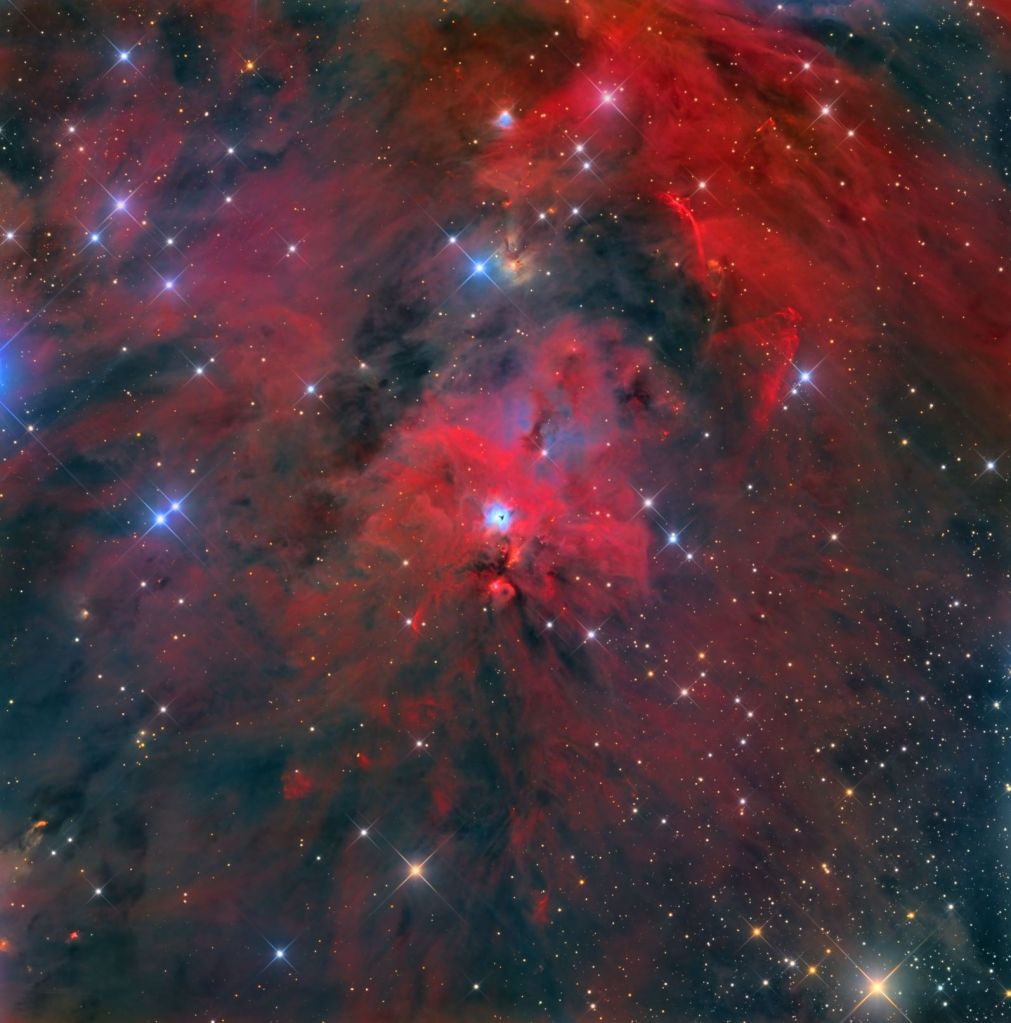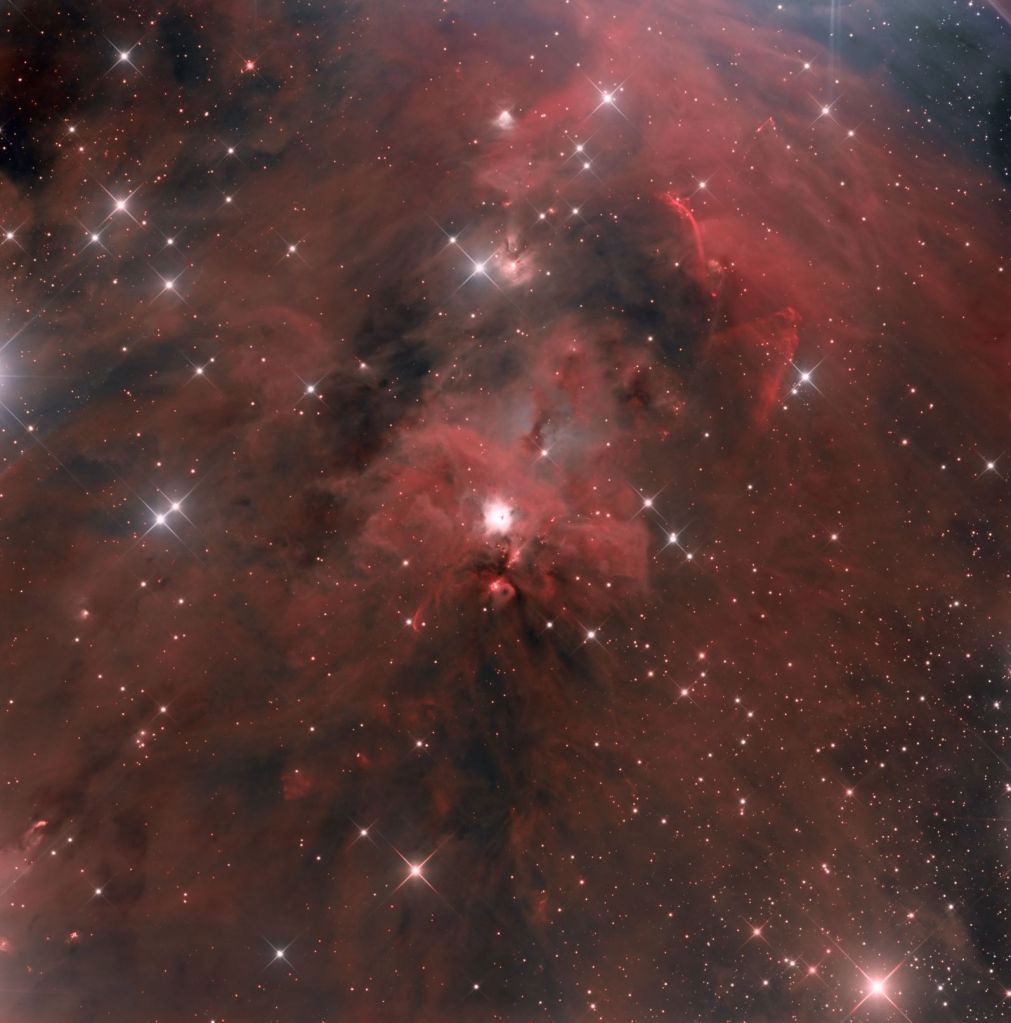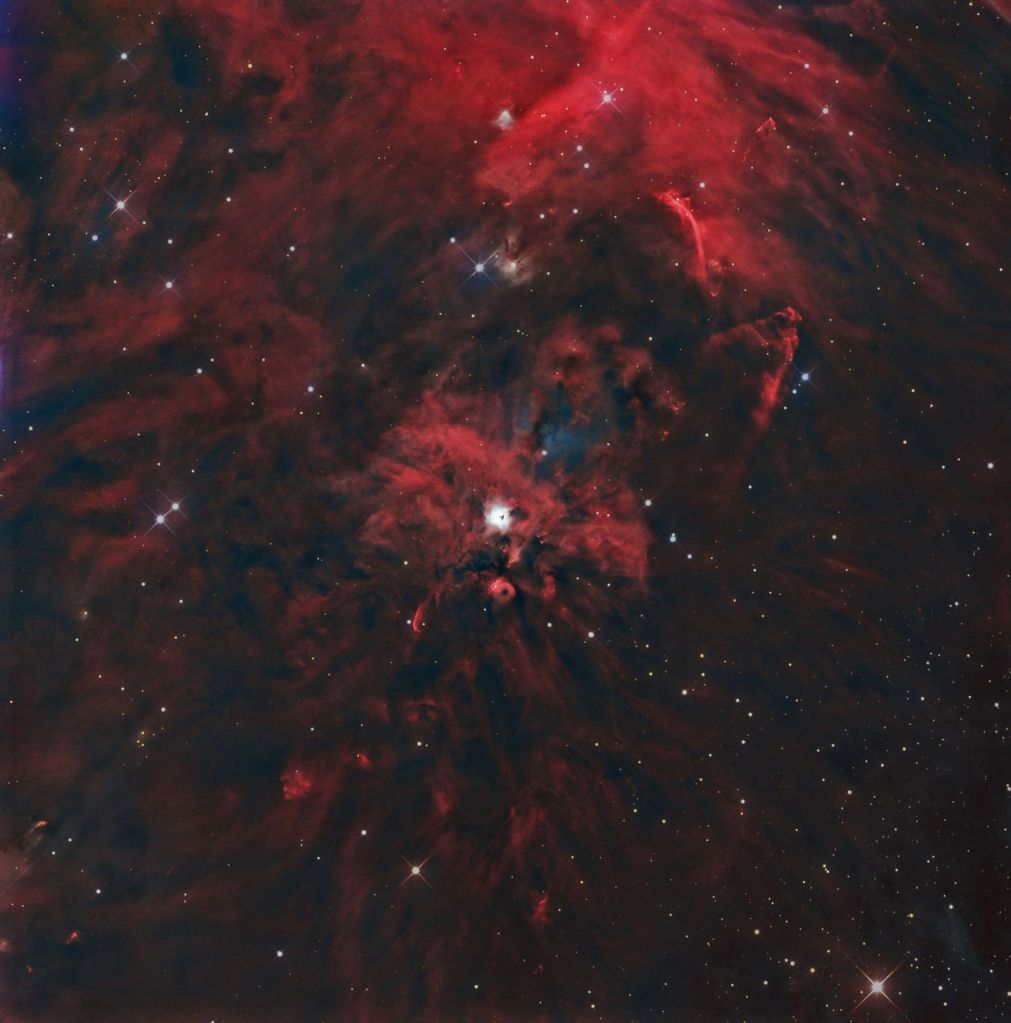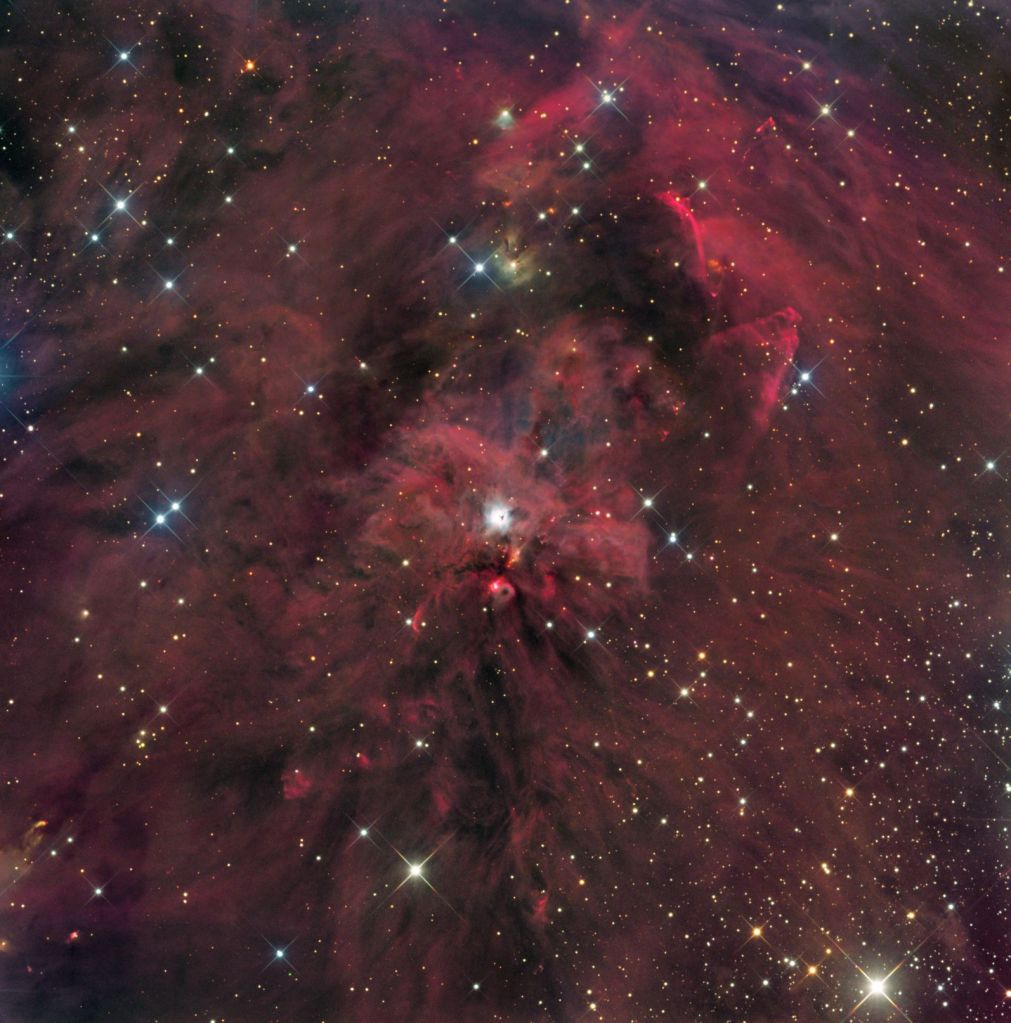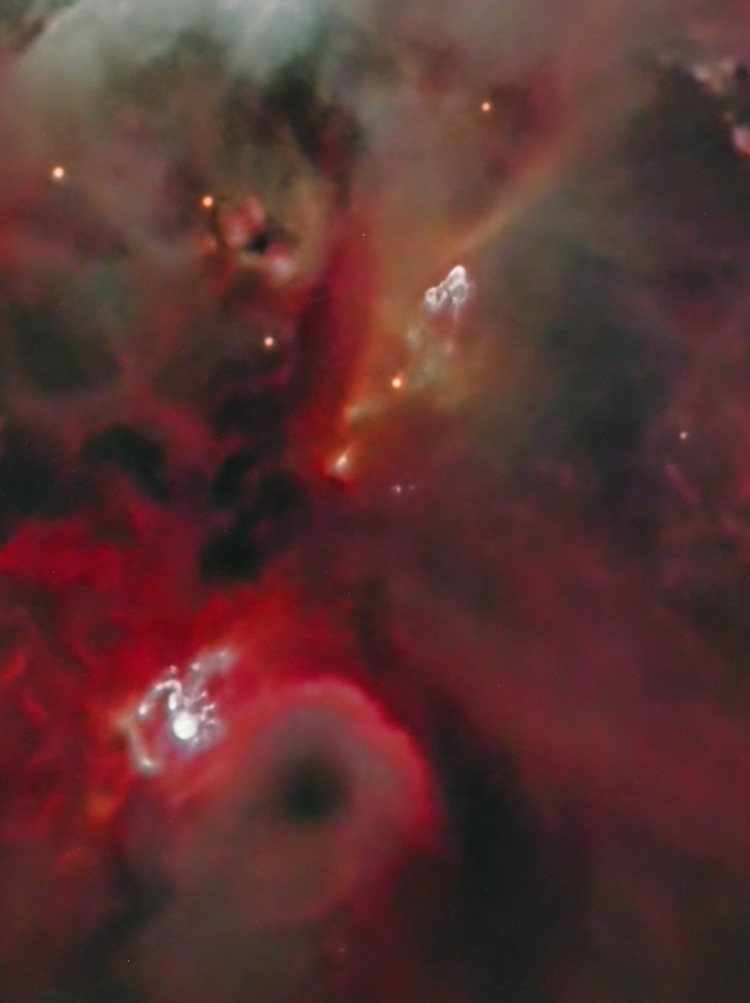di Alessandro Ravagnin and ShaRA Team
Il team ShaRA, per il sesto progetto, è sbarcato in una zona di cielo molto fotografata: Orione. Poco più a sud della celeberrima M42, esiste una bellissima nebulosa a riflessione denominata NGC1999 Il Buco della Serratura. E’ un oggetto visibile anche alle nostre latitudini, ma vista l’estrema debolezza della zona e viste le ridotte dimensioni della parte centrale, abbiamo deciso di concentrare i nostri sforzi per ottenere una splendida visione sfruttando il cielo incontaminato del Cile e la potenza dei due principali telescopi (il mezzo metro ed il metro) del servizio remoto che attualmente usiamo.
ShaRA#6: il target
Il buco della serratura cosmica è una nebulosa piena di polvere con un vasto buco di spazio vuoto rappresentato da una macchia nera di cielo attorniata da una vasta regione di idrogeno ionizzato. È una nebulosa a riflessione e brilla della luce della stella variabile V380 Orionis. In precedenza si credeva che la macchia nera fosse una densa nube di polvere e gas che bloccava la luce che normalmente la attraversava, chiamata nebulosa oscura, ma a seguito delle riprese del telescopio a infrarossi Herschel si è potuto appurare che il buco è proprio uno spazio nero continuo. Ciò ha portato a credere che il materiale della nube fosse immensamente denso o che fosse stato rilevato per la prima volta un nuovo fenomeno inspiegabile. Con il supporto di osservazioni da terra effettuate utilizzando le fotocamere bolometriche submillimetriche del radiotelescopio Atacama Pathfinder Experiment e dei telescopi Mayall (Kitt Peak) e Magellan, è stato determinato che la macchia è veramente vuota. La causa esatta di questo fenomeno è ancora in fase di studio, anche se è stato ipotizzato che stretti getti di gas provenienti da alcune delle giovani stelle della regione abbiano perforato lo strato di polvere e gas, così come la potente radiazione proveniente da una vicina stella matura potrebbe aver contribuito a creare il buco.
Oltre a questa nebulosa oscura, la regione è meravigliosa da riprendere con telescopi di lunga focale anche perchè è ricca di oggetti di Herbig-Haro.
Gli oggetti HH sono delle nebulose a emissione molto deboli, visibili nelle zone di formazione stellare, formatesi grazie al gas ionizzato, espulso in forma di getti di plasma dai poli di stelle in fase di formazione, che collidendo a velocità supersoniche con zone dense di gas e polveri ne eccitano gli atomi, rendendo queste ultime luminose per effetto di triboluminescenza. La maggior parte di essi si trova entro circa un parsec (3,26 anni luce) dalla sorgente, sebbene alcuni siano stati osservati a diversi parsec di distanza. Gli oggetti HH sono fenomeni transitori che durano circa poche decine di migliaia di anni. Possono cambiare visibilmente su scale temporali di pochi anni mentre si allontanano rapidamente dalla stella madre verso le nubi di gas dello spazio interstellare. Le osservazioni del telescopio spaziale Hubble hanno rivelato la complessa evoluzione degli oggetti HH nel corso di pochi anni, poiché parti della nebulosa sbiadiscono mentre altre si illuminano quando entrano in collisione con il materiale grumoso del mezzo interstellare.
ShaRA#6: il progetto
Veniamo dunque alle riprese dell’ultima fatica del gruppo. Innanzitutto c’è da dire che le sessioni di ripresa son state rocambolesche: abbiamo dovuto fare uno sterminio di nottate di ripresa perchè l’oggetto, nel periodo Ottobre/Novembre, sorgeva tardi durante la notte cilena e molte riprese son saltate a causa del cattivo tempo (cielo velato o nuvoloso).
L’elaborazione è stata altrettanto complicata a causa delle brillantissime stelle della spada di Orione, appena fuori dal campo inquadrato: enormi lame di luce (gli spike delle stelle) e forti gradienti inquinavano il FoV: si è dovuto lavorare parecchio per sistemare il tutto e rendere l’immagine il più pulita possibile.
Il superstacking inoltre ha raggiunto il suo record di contributi: 19!!! Ecco qua tutti i partecipanti:
| Bertocco Andrea | Chander Vikas | Curzi Simone |
| Di Fusco Massimo | Erkaslan Aygen | Firenzuoli Marco |
| Grizzuti Antonio | Iorio Andrea | Ligustri Rolando |
| Linsalata Fernando | Lioce Donato | Loro Antonio |
| Maffioli Riccardo | Michieletto Giampaolo | Pazienza Gianluigi |
| Privitera Christian | Ravagnin Alessandro | Trabuio Cristiano |
| Vergani Egidio |
Ecco gli elaborati dei singoli, ottenuti utilizzando 42x600s sub di Luminanza, 3x15x600s RGB e 17x600s di Halpha fatti col T3 in Cile:
E il superstack finale ottenuto con la solita formula dopo le votazioni anonime sui singoli elaborati
ShaRA#6 = Pazienza * 0,06 + Trabuio * 0,09 + Loro * 0,01 + Lioce * 0,15 + Ravagnin * 0,12 + Chander * 0,05 + Bertocco * 0,03 + Curzi * 0,07 + Privitera * 0,01 + Iorio * 0,07 + Vergani * 0,05 + Ligustri * 0,07 + Maffioli * 0,02 + Grizzuti * 0,06 + Erkasla * 0,04 + Linsalata * 0,04 + Firenzuoli * 0,01 + DiFusco * 0,04 + Michieletto * 0,01

Abbiamo fatto anche una sessione di 11x600s di Luminanza col T1, ecco qua il risultato (mia elaborazione).
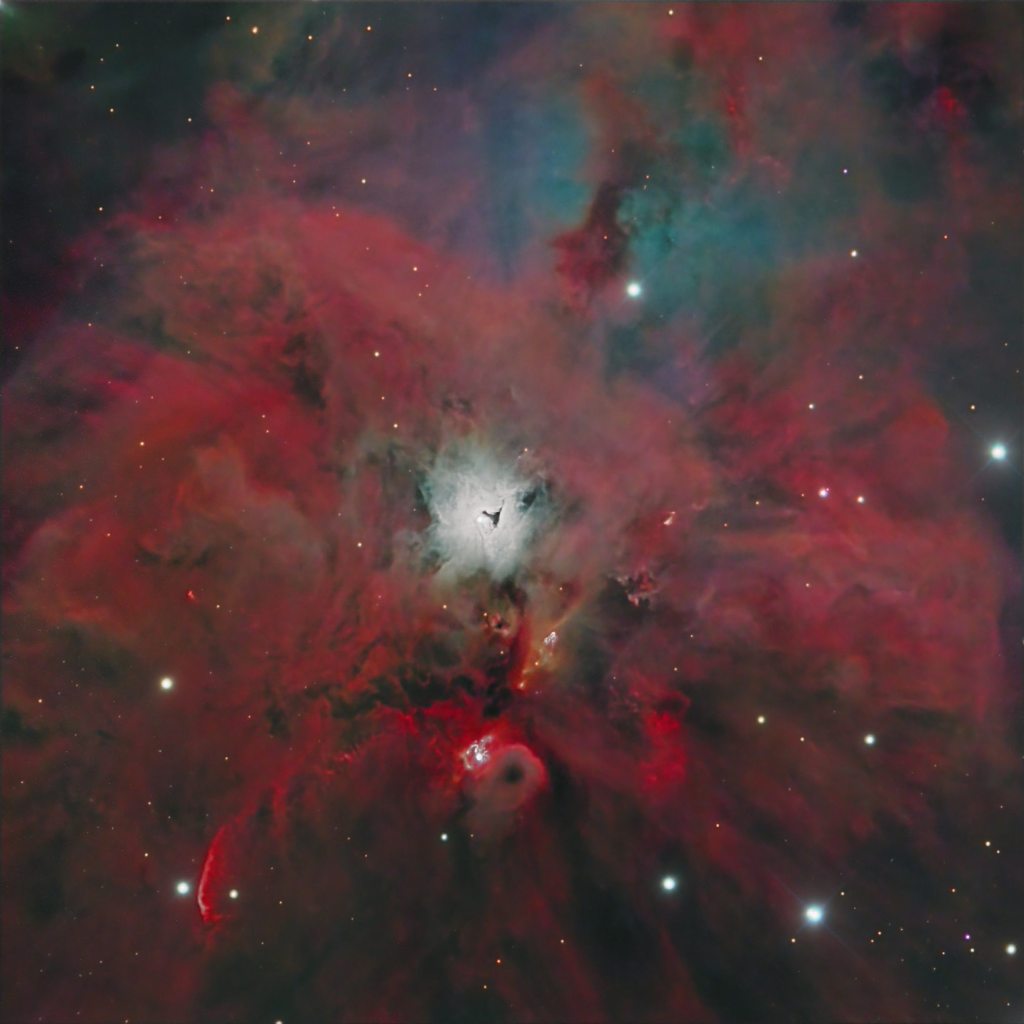
Un po’ di confronti quindi con le immagini HST e l’immagine del NORILAB realizzata col 4 metri Mayall.
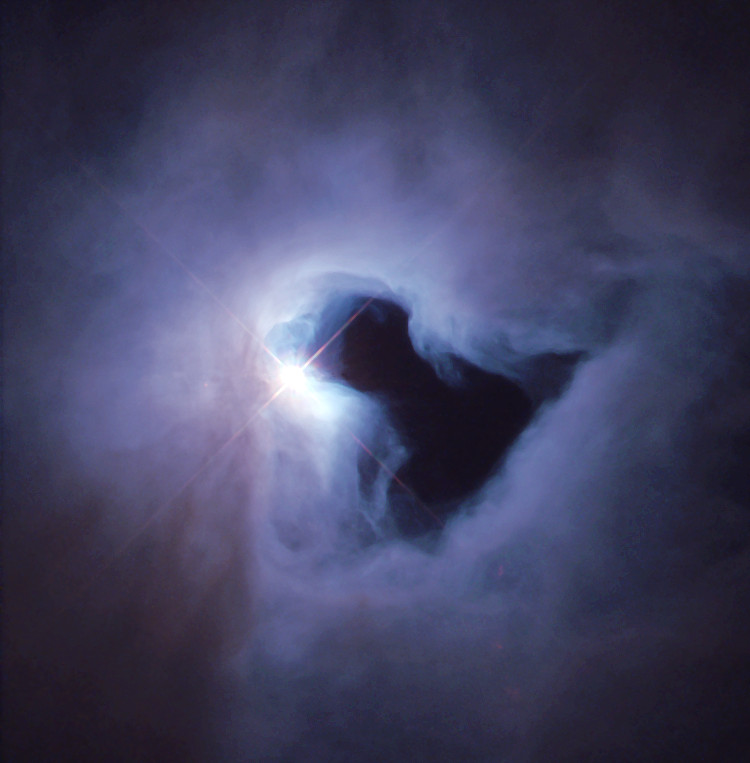


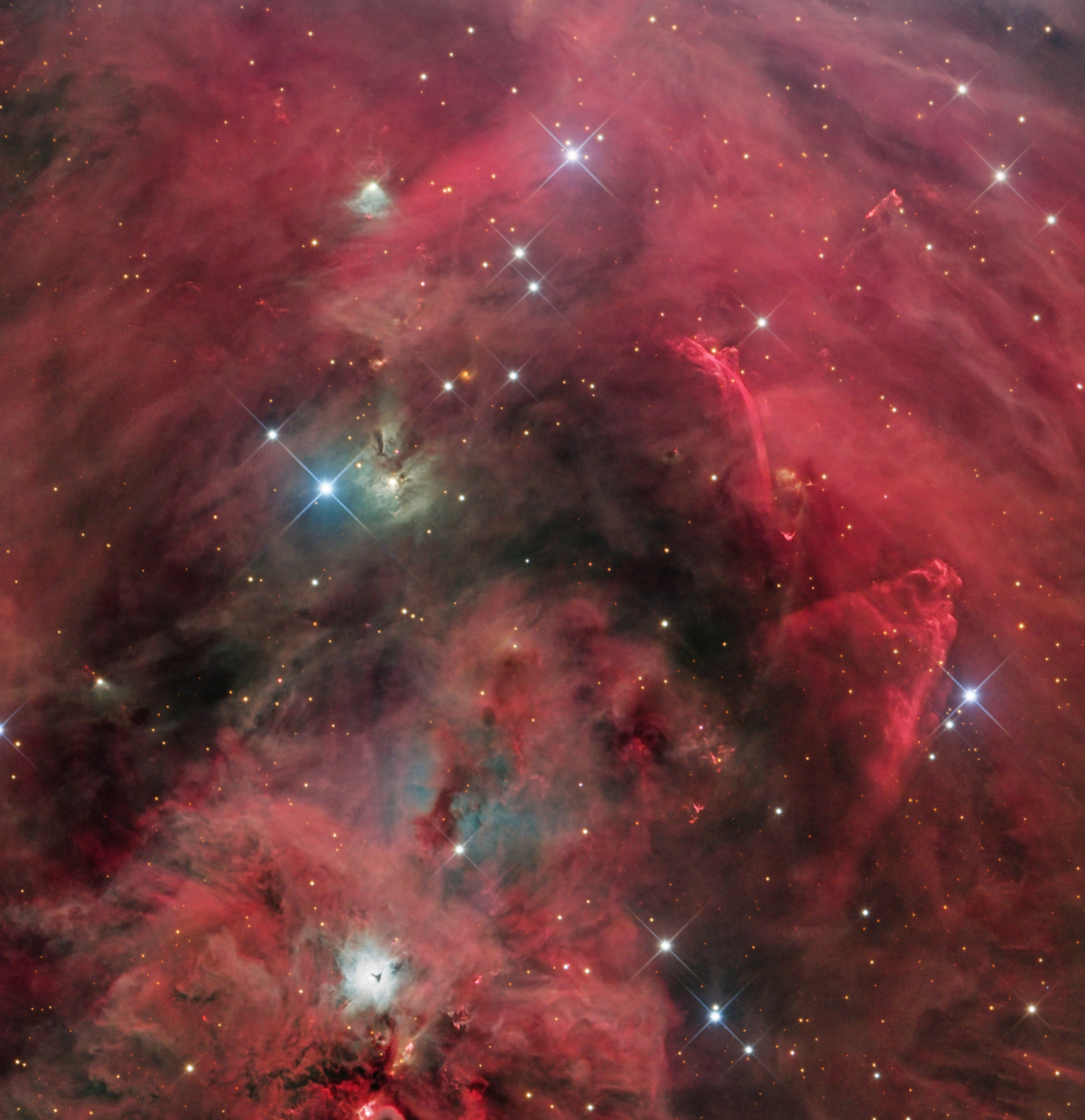
Infine la carrellata di oggetti di Herbig-Haro individuati nell’immagine:

Coi relativi ingrandimenti, dai quali si possono evincere le peculiari forme dei bow-shock dei getti delle stelle in formazione:
Sono riuscito a confrontare le immagini con quelle storiche di HST (ultima del 2014) ed ho avuto modo di verificare i cambiamenti morfologici dell’oggetto HH più luminoso della regione (e quello più luminoso in assoluto in cielo): HH1 e HH2.


Ecco qua il dettaglio su HH1 e quindi a seguire HH2. Il primo si vede essersi espanso verso l’alto e verso destra (nord – ovest), mentre il secondo sembra aver continuato l’incremento di luminosità del globulo registrato dai ricercatori nel 2007.


Con questo passo e chiudo e ci si rivede nel 2024 con altri bellissimi progetti!!!
NGC1999 The Cosmic Key Hole
The ShaRA team, for the sixth project, landed in a much photographed area of the sky: Orion. Just south of the famous M42, there is a beautiful reflection nebula called NGC1999 The Keyhole. It is an object visible even at our latitudes, but given the extreme weakness of the area and given the small size of the central part, we decided to concentrate our efforts on obtaining a splendid vision by exploiting the pristine sky of Chile and the power of the two main telescopes (the half meter and the meter) of the remote service that we currently use.
ShaRA#6: the target
The cosmic keyhole is a dust-filled nebula with a vast hole of empty space represented by a black patch of sky surrounded by a vast region of ionized hydrogen. It is a reflection nebula and shines with the light of the variable star V380 Orionis. Previously it was believed that the black spot was a dense cloud of dust and gas that blocked the light that normally passed through it, called a dark nebula, but following footage from the Herschel infrared telescope it was possible to ascertain that the hole is indeed a space continuous black. This led to beliefs that the cloud material was immensely dense or that a new, unexplained phenomenon had been detected for the first time. With the support of ground-based observations made using the submillimeter bolometer cameras of the Atacama Pathfinder Experiment radio telescope and the Mayall (Kitt Peak) and Magellan telescopes, it was determined that the spot is truly empty. The exact cause of this phenomenon is still being studied, although it has been hypothesized that narrow jets of gas from some of the young stars in the region have pierced the layer of dust and gas, as has powerful radiation from a nearby star. couple may have helped create the hole.
In addition to this dark nebula, the region is wonderful to image with long focal length telescopes also because it is rich in Herbig-Haro objects. HH objects are nebulae with very weak emission, visible in star formation zones, formed thanks to ionized gas, expelled in the form of plasma jets from the poles of forming stars, which colliding at supersonic speeds with dense zones of gas and dust excite the atoms, making them luminous due to the triboluminescence effect. Most of them are within about a parsec (3.26 light-years) of the source, although some have been observed several parsecs away. HH objects are transient phenomena that last about a few tens of thousands of years. They can change visibly on time scales of a few years as they move rapidly away from their parent star toward the gas clouds of interstellar space. Observations from the Hubble Space Telescope have revealed the complex evolution of HH objects over the course of a few years, as parts of the nebula fade while others brighten when they collide with the lumpy material of the interstellar medium.
ShaRA#6: the project
So let’s get to the filming of the group’s latest effort. First of all, it must be said that the shooting sessions were daring: we had to do an extermination of shooting nights because the object, in the October/November period, rose late during the Chilean night and many shots were skipped due to the bad weather (hazy or cloudy sky). The processing was equally complicated due to the very bright stars of Orion’s sword, just outside the frame: enormous blades of light (the spikes of the stars) and strong gradients polluted the FoV: a lot of work had to be done to arrange everything and make the image as clean as possible. Superstacking also reached its record of contributions: 19!!! Here are all the participants:
| Bertocco Andrea | Chander Vikas | Curzi Simone |
| Di Fusco Massimo | Erkaslan Aygen | Firenzuoli Marco |
| Grizzuti Antonio | Iorio Andrea | Ligustri Rolando |
| Linsalata Fernando | Lioce Donato | Loro Antonio |
| Maffioli Riccardo | Michieletto Giampaolo | Pazienza Gianluigi |
| Privitera Christian | Ravagnin Alessandro | Trabuio Cristiano |
| Vergani Egidio |
Here are the results of the singles, obtained using 42x600s sub of Luminance, 3x15x600s RGB and 17x600s of Halfha made with T3 in Chile:
And the final superstack obtained with the usual formula after anonymous voting on the individual entries:
ShaRA#6 = Pazienza * 0,06 + Trabuio * 0,09 + Loro * 0,01 + Lioce * 0,15 + Ravagnin * 0,12 + Chander * 0,05 + Bertocco * 0,03 + Curzi * 0,07 + Privitera * 0,01 + Iorio * 0,07 + Vergani * 0,05 + Ligustri * 0,07 + Maffioli * 0,02 + Grizzuti * 0,06 + Erkasla * 0,04 + Linsalata * 0,04 + Firenzuoli * 0,01 + DiFusco * 0,04 + Michieletto * 0,01

We also did a session of 11x600s of Luminance with T1, here is the result (my elaboration).

So a few comparisons with the HST images and the NORILAB image created with the 4-meter Mayall.




Finally the overview of Herbig-Haro objects identified in the image:

With the relative enlargements, from which the peculiar shapes of the bow-shocks of the jets of the stars in formation can be deduced:
I was able to compare the images with the historical ones from HST (latest from 2014) and I was able to verify the morphological changes of the brightest HH object in the region (and the brightest one overall in the sky): HH1 and HH2.


Here is the detail on HH1 and then HH2 to follow. The first is seen to have expanded upwards and to the right (north – west), while the second seems to have continued the increase in brightness of the globule recorded by researchers in 2007.


With this I’m done and I’ll see you again in 2024 with other beautiful projects!!!



